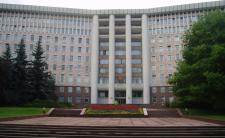Situated in southeastern Europe, the Republic of Moldova is bounded by Romania to the west and Ukraine to the north, east and south. It occupies approximately 33,700 square kilometers and has a population of some 4,5 million. The majority of Moldovans are of Romanian origin. The country is divided into two regions: Bessarabia, which is predominantly ethnic Romanian and constitutes the land between the Prut and Dniester rivers in the eastern half of the region, and Transnistria, the land on the east bank of the Dniester River with a majority of the population being Slavic. In 1990, Transnistria declared its independence and became an internationally unrecognized state, known as the Pridnestrovian Moldavian Republic.
Political system and history
The Republic of Moldova has a mixed system of government. It has a dual executive consisting of a President, Prime Minister, Council of Ministers and a unicameral legislature. Judicial review of the constitutionality of laws is performed by the Constitutional Court.
Following Turkish and Russian wars, much of Moldova was transferred to Russian control and called Bessarabia in 1812. In 1917, Bessarabia proclaimed the independent Democratic Republic of Moldova and united with Romania in 1918. In 1924, the USSR established the Moldovan Autonomous Oblast on the east of the Dniester River in the Ukrainian Soviet Socialist Republic. Shortly afterwards, the oblast’s status was altered into the Moldovan Autonomous Soviet Socialist Republic (MASSR). At the beginning of World War II, the Soviet forces occupied Bessarabia and rejoined it to the MASSR, thereby forming the Moldovan Soviet Socialist Republic. During World War II Moldova returned to Romania, but was handed over to the USSR in 1947. Following the collapse of the Soviet Union, Moldova finally became independent on 27 August 1991.
Constitutional history and development
The first constitution of the Moldavian Socialist Republic (MSSR) was based on the 1936 Soviet Constitution and adopted on 12 January 1941. It was replaced in 1978 by a new republican constitution, drafted in light of the provisions of the 1977 Constitution of the Soviet Union.
Following the declaration of independence on 27 August 1991, Moldova substituted the old Soviet Constitution of 1978 by adopting a new fundamental law on 28 July 1994. The new constitution introduced the institutional framework of Moldova’s current political system. It provides for a unicameral Parliament, a popularly elected President, and substantial autonomy to the regions of Transnistria and Gagauzia. In 2000, a constitutional amendment endowed the Parliament with the power to elect the President. In light of the Parliament’s failure to fulfill this duty, a referendum in 2010 tried to reintroduce direct presidential elections to the country, but failed as the turnout requirements were not met.
The Executive
The President is the Head of State and serves as the Commander in Chief of the armed forces. The President is competent to initiate laws and address the legislature on several matters. He enjoys the right to dissolve the Parliament and suspend acts of the government under certain circumstances. His duties moreover include negotiating and concluding international treaties, accrediting high officials, conferring medals and other honorary ranks, resolving citizenship disputes as well as granting political asylum and individual pardons. The President is elected by a three fifths majority of the legislature. After two consecutive terms of office, reelection is precluded. As a precondition, the President shall be proficient in the Moldovan language, have lived in the country not less than 10 years, and be at least 40 years of age.
The powers and duties of the Prime Minister include informing the president of “matters of special importance” and nominating and coordinating the government. Nominated by the President, the Prime Minister is subsequently approved by Parliament by a vote of confidence.
The government’s task is to implement the domestic and foreign policy of the nation. A “specific programme of activities” is subject to approval by the Parliament and serves as a guideline for the government. Aside from the Prime Minister, the government compiles the first Vice Prime Minister, the other Vice Prime Ministers, Ministers, and other persons specified by an organic law.
The Legislature
The unicameral Parliament has the power to elect the President and enjoys vast oversight powers over the executive branch. It is the country’s supreme representative body and its 101 members are directly elected for a four-year term of office. This term may be shortened through dissolution or extended for one year in the event of a war or catastrophe.
The right to initiate legislation is granted to the Parliament, Deputies, the President, the government and to the people’s assembly of the Gaugazian region. In addition to its far-reaching institutional autonomy, the legislature has many different competencies, including the powers to enact legislation, control the executive, interpret laws, ensure the uniformity of legislation in Moldova, call for referendums, approve the overall direction of democratic and foreign policy as well as the military policy. Furthermore, it is responsible to approve international treaties and the state budget, grant amnesty and declare a state of emergency.
The Judiciary
The judicial system consists of the Supreme Court of Justice, the Court of Appeal, Tribunals and the Courts of Law. According to the constitution, courts of exception are forbidden. The structure and competencies of the courts are established by organic law. Judges are nominated by the legislature, the government and the superior council of the magistrature, each of those bodies selecting two candidates. Judges are appointed at first for a five-year term, followed by ten years, and subsequently judges are appointed until the age of retirement. Moreover, article 116 states that judges “are independent, impartial (…) under the law”.
Pursuant to the constitution, the Constitutional Court is “the sole authority of constitutional judicature” and “independent of any other public authority and obeys only the Constitution”. Amongst others, the nine judges of the Constitutional Court shall guard the implementation of the notion of the separation of state powers into the three branches. Once appointed, judges of the Constitutional Court cannot be removed.
Constitutional and political challenges
Moldova is confronted with various challenges. The countries electoral code led to a political deadlock over the Presidency and a vast number of failed elections. Regarding constitutional changes, the Venice Commission therefore recommended amongst others to remove turnout requirements for elections to be recognized as valid; not to increase legal thresholds for winning parliamentary seats; to clearly allocate powers and competences to the different responsible bodies for the review of complaints and appeals in order to avoid conflicts of jurisdiction; and to regulate the conditions for de-registering candidates or lists of candidates.
Moreover, the country’s complex ethnic composition and the transformation of the political and economic system after the Soviet period pose continuous difficulties to the government. To unify the country and agree on the status of the region Transnistria is another unsolved issue. The lack of local representation in Parliament keeps political elites out of touch with the rest of the country and the courts are politicized and subject to pressure. Also, the poverty throughout the population poses the question on how to achieve economic growth and allow all the citizens to benefit from its effects. Finally, the way towards European integration remains in an early stage of development.
System of Government
Timeline
| 16th - early 19th century | Moldovan territory disputed by several powers with the Ottoman Empire and Russia as the main rivals. Numerous wars. |
| 1812 | Treaty of Bucharest grants Russia control of eastern Moldova or Bessarabia. |
| 1918 | Bessarabia declares independence and forms union with Romania. |
| 1924 | Moldovan Autonomous Soviet Socialist Republic established within Ukraine. |
| 1939 | Romania divided in pact between Hitler's Germany and Stalin's USSR. Bessarabia is one of the areas to go to the USSR. |
| 1940 | Russia annexes Bessarabia and adjoins it to most of the Moldovan Autonomous Soviet Socialist Republic. Moldavian Soviet Socialist Republic (MSSR) is formed. |
| 1941-1945 | Romanian puppet regime installed by Nazi Germany in MSSR but shortly afterwards the Soviet Union regains control. |
| Late 1980s | Moldovan nationalism in the wake of the “Perestroika” . |
| 1989 | Romanian is reinstated as the official language. The Latin script replaces the Cyrillic script. |
| 1990 | Moldova declares its sovereignty. The Gagauz people in the southwest declare their independence, followed by the Transnistrian region. |
| 1991 | Moldova declares its independence. It joins the Commonwealth of Independent States, the successor to the Soviet Union. |
| 1992 | Moldova becomes a member of the United Nations. Uprisings in Transnistria. |
| 1994 | A new constitution is proclaimed. The Transnistrian and the Gagauz regions are granted special autonomy status, and Moldovan is declared the official language. |
| 1995 | Death penalty abolished. |
| 1997 | Negotiations resumed with Transnistria. |
| 1999 | OSCE summit in Istanbul sets end of 2002 as deadline for withdrawal of Russian troops and ammunition from Transnistria. |
| 2002 | Announcement of plans to make Russian an official language and compulsory in schools leads to protests. The plans are hereupon shelved. |
| 2002 | Transnistrian authorities agree to allow resumption of Russian withdrawal in exchange for a Russian promise to cut gas debts. |
| 2002 | OSCE extends deadline for withdrawal of Russian weapons from Transnistria until end of 2003. The deadline is later extended into 2004. |
| 2004 | Dispute over closures of Moldovan-language schools in Transnistria using Latin rather than Cyrillic script. Moldova leaves talks on the region’s status. |
| 2006 | Russia cuts off gas supplies when Moldova refuses to pay a higher price. |
| 2006 | Transnistrian referendum vote backs independence from Moldova and a plan eventually to become part of Russia. |
| 2010 | Constitutional Court orders new parliamentary election to end deadlock over parliament's incapability to elect president. |
| 2010 | Referendum to reintroduce direct election of president fails on account of low turnout. |
| 2010 | Third parliamentary election in less than two years. |
Bibliography
- British Broadcasting Corporation. Moldova Country Profile. 2011. Web 18 Jul 2011.
- British Broadcasting Corporation. Moldova timeline. 2011. Web. 15 Jul 2011.
- Central Intelligence Agency. The World Factbook: Moldova. Web. 14 Jul 2011.
- Encyclopedia of the Nations. Moldova – History. Web. 14 Jul 2011.
- European Commission for Democracy through Law (Venice Commission). Opinion No. 576/2010 of 7 June 2010 on the Draft Working Text Amending the Election Code of Moldova. Web. 14 Jul 2011.
- Dabrowski, Marek. Center for Social and Economic Research. Moldova: Major Economic Problems and Challenges. Chisinau; Warsaw. March / April 2003.
- Fish, Steven M., Kroenig, Matthew. The Handbook of National Legislatures. 2009. Cambridge University Press.
- Mongbay. Moldova – History. Web. 14 Jul 2011.
- The Economist. A Moldovan Fiasco. 6 Sept 2010. Web. 14 Jul 2011.
- United States. Background Note: Moldova. 2011. Web. 14 Jul 2011.
| Branch | Hierarchy | Powers | Removal |
|---|






Share this article